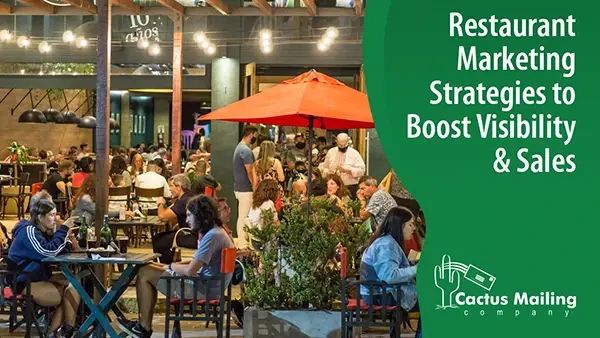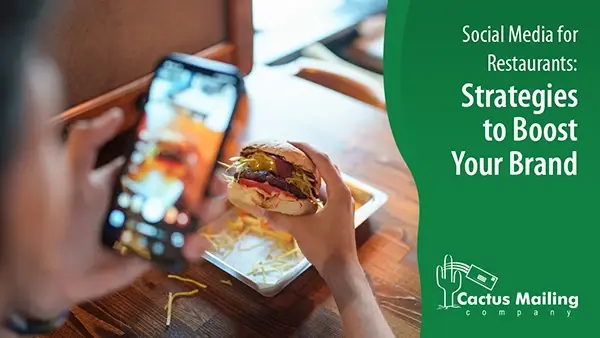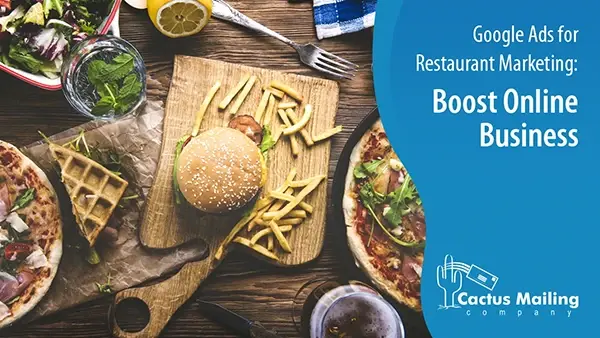We Are Here to Help!
Get pricing details and strategies that will work for your business.
Restaurant marketing is a dynamic and essential process for any dining establishment aiming to thrive in today’s competitive food industry. By effectively promoting your restaurant, you attract customers and create a loyal following. Given the plethora of various marketing materials and channels available, from digital platforms to traditional advertising, selecting the right combination tailored to your restaurant business can determine your restaurant’s success. It's crucial that your restaurant marketing success plan is not just a one-off campaign but an ongoing strategy that adapts with your business growth and changes in customer behavior.
In the food business, the optimization of all social media platforms, SEO, and online reviews have never been more important to one's restaurant marketing strategy. You want your restaurant's brand identity to resonate with your target audience and reflect the quality and experience you promise. Combining user feedback and data analytics can lead to a deeper understanding of your customer base and how you can tailor your service and menu items to achieve an excellent customer satisfaction rating.
Key Takeaways
- Adopt a comprehensive marketing strategy for your restaurant to stand out.
- Establish a consistent brand identity to connect with your existing customers and audience.
- Use data analytics to inform and enhance your marketing decisions.
Developing a Strong Brand Identity
Creating a strong brand identity is essential for your restaurant's visibility and success. It encompasses everything from your brand voice to the visuals that make your space Instagram-worthy, ensuring your message is consistent across all platforms.
Defining Your Brand Voice
Your brand voice is the personality and emotion infused into your restaurant's communications. It should reflect who you are as a brand and resonate with your target audience. To create a compelling brand voice, consider the language and tone that align with your restaurant's values and mission. Whether it's friendly and casual or sophisticated and professional, your restaurant brand and voice is vital in communicating your unique selling proposition to customers.

Creating an Instagrammable Concept
An Instagrammable restaurant draws customers in and encourages them to post their experiences. Doing so boosts brand awareness through organic content from your patrons. Incorporate visual elements that stand out, like distinctive decor or plating styles, to ensure every corner of your restaurant can be used as a backdrop for your customers' next IG post. This turns diners into brand ambassadors, as their posts will naturally promote your restaurant.
Importance of Brand Consistency
Once you have executed your restaurant marketing idea, it's important to keep your brand identity consistent. You need to see to it that your brand voice, visuals, and overall great customer service and experience are harmonious across all touchpoints—from your menu design to your online presence. Your restaurant's brand is reinforced by consistent branding, which improves customer recognition and loyalty. Every interaction is an opportunity to cement your brand in your customer's minds.
Crafting an Effective Restaurant Marketing Plan
When you set out to develop a marketing plan, it's crucial to anchor your strategy with clear, actionable goals and a well-defined budget that guides your promotional activities.
Setting Marketing Goals
Begin by identifying your specific marketing goals. This could include increasing foot traffic by 20%, boosting online reservations by 30%, or growing your social media following by 50%. Each goal you set should be measurable and time-bound, providing you with clear targets to aim for. This aspect of your marketing plan forms the foundation upon which all strategies are built.
Allocating a Marketing Budget
Your marketing budget is the financial blueprint that supports the achievement of your marketing goals. It’s important to allocate funds wisely across various channels. Start with a table to clearly visualize your budget allocation:
|
Marketing Channel |
Budget Percentage |
Goal Impact |
|
Social Media |
30% |
High |
|
Local Marketing |
25% |
Medium |
|
Events |
15% |
Medium |
|
Email Campaigns |
20% |
High |
|
Public Relations |
10% |
Low |
By assigning percentages and expected impact, you can prioritize the channels most likely to help you reach your goals and maximize your return on investment. Remember, your budget should remain flexible to adapt to unexpected opportunities or shifts in the market.
Optimizing Your Marketing Mix
To effectively reach your audience and maximize returns, fine-tuning your restaurant's marketing mix is essential. This involves strategic management of various channels to create a cohesive marketing campaign that appeals directly to your target market.
Enhancing Your Restaurant Website
Your website functions as the digital storefront of your restaurant. To make it as efficient as possible, ensure that it is SEO-optimized for better search engine visibility, and that the landing page clearly communicates your unique selling proposition. Feature online ordering capabilities prominently for a seamless user experience and further guest engagement to drive sales.
- Search Engine Optimization: Use relevant keywords in your website content, titles, and meta descriptions to improve search engine rankings. Tools like Google Keyword Planner can help identify popular terms in your niche.
- User-Friendly Design: Ensure your website is easy to navigate, with a simple menu, appealing visuals, and quick loading times. Utilize responsive design so that it looks good on both desktop and mobile devices.
- Online Ordering System: Integrate an efficient restaurant online ordering system. Offer options like pick-up, food delivery apps, and table reservations.
- Showcasing Your Menu: Have a well-organized, updated menu with high-quality photos of your dishes.
- Landing Page: Your landing page should capture your brand’s essence and include a clear call to action (CTA), like a reservation button or a link to view the menu.

Google My Business for Higher Visibility
Leverage Google My Business to increase your restaurant's online visibility. Keep your Google Business profile updated to ensure that potential customers find accurate information when they search for you. Regularly post updates and photos, and actively manage customer reviews to maintain a strong online presence.
- Complete and Accurate Information: Ensure that your GMB listing includes up-to-date information about your location, hours, contact details, and services.
- Regular Posts and Updates: Share updates about new menu items, special events, or restaurant promotions. This keeps your listing active and engaging.
- Photos and Videos: Upload high-quality images of your restaurant, food, and events. Consider adding a virtual tour of your restaurant.
- Review Management: Promptly respond to both positive and negative reviews to show that you value customer feedback.
Implementing Email Marketing
Start email marketing by building a subscriber list from your customer base. Use personalized, content-rich emails to keep your restaurant top-of-mind. Including exclusive deals or sneak peeks at new menu items can improve open rates and customer engagement.
- Building a Subscriber List: Offer incentives for a loyal customer to sign up for your emails, like a discount on their next visit.
- Segmentation: Segment your email list based on customer preferences or behavior to send more targeted and relevant content.
- Regular Newsletters: Send out monthly or weekly newsletters with updates, special offers, and interesting content related to your restaurant.
- Event and Promotion Alerts: Use email to inform subscribers about upcoming events or exclusive promotions.
Utilizing Targeted Direct Mail
Though digital is king, don't overlook the impact of targeted direct mail. By sending well-crafted postcards or menus to a carefully selected local audience, you can draw attention to your restaurant and entice new clientele.
- Localized Targeting: Focus on areas within a certain radius of your restaurant's intended marketing activities. Use demographic data to target potential customers who match your typical customers..
- Tracking and Analysis: Include unique codes or offers in your mailings to track their effectiveness.
Managing Social Media Platforms
Effectively managing social media platforms involves more than just casual postings. Create a content calendar, post high-quality images of your dishes, regularly engage with your followers, and use targeted ads to reach a broader audience. Social media marketing is a powerful tool for building a community around your brand.
- Content Calendar: Plan your upcoming marketing campaigns and social media platform posts. Balance promotional content with creative restaurant marketing ideas that can be engaging, fun, and informative.
- High-Quality Visuals: Post professional photos of your dishes, behind-the-scenes content, and snapshots from events.
- Engagement: Regularly engage with your audience, whether a repeat or new customer, by responding to comments, messages, and reviews.
- Targeted Advertising: Use social media advertising to reach potential customers based on location, interests, and behaviors.
- Influencer Partnerships: Collaborate with other local businesses, food bloggers or influencers to reach a wider audience.

Optimizing Social Media Accounts
Several platforms might be essential to effectively engage with your audience and promote the business. Here are some content suggestions for your restaurant social media marketing:
1. Instagram
Instagram is perfect for visually driven content and has a large user base that actively engages with food-related posts.
Content Examples:
- Daily Specials: Post high-resolution photos of your daily specials or new menu items, with a brief description and an enticing call to action.
- Behind-the-Scenes: Share videos or stories showing the preparation process, kitchen action, or your team at work to create a personal connection with your audience.
- Customer Reviews and UGC: Feature user-generated content such as customer photos, reviews, or testimonials. If other people have excellent feedback, or a helpful restaurant marketing idea, reposting them is a good way to both give credit to the person and create content.
2. Facebook
Facebook's broad demographic makes it an excellent platform for sharing a variety of content and connecting with a diverse audience.
Content Examples:
- Events and Promotions: Post about upcoming events, special promotions, or themed nights at your restaurant.
- Live Videos: Use Facebook Live to broadcast events happening at your restaurant, like a live cooking demo or a tour of your dining space.
- Interactive Posts: Engage your audience with polls, Q&A sessions, or contests related to your restaurant or cuisine.
3. Pinterest
Pinterest is a visually appealing platform suited for showcasing your local restaurant’s ambiance and menu offerings in a more permanent, catalog-like format.
Content Examples:
- Menu Item Boards: Create boards for different types of dishes (e.g., appetizers, main courses, desserts) with attractive images and recipes or descriptions.
- Themed Event Ideas: Share photos from themed events at your restaurant or post ideas for seasonal decorations and special menus.
- Infographics: Post infographics about food facts, cooking tips, or wine pairings that align with your restaurant's theme.
4. X or Twitter
Twitter is ideal for real-time engagement and sharing quick updates, making it a great platform for conversations between the restaurant and its customers.
Content Examples:
- Flash Deals: Announce limited-time offers or discounts to drive immediate traffic.
- Industry News and Trends: Share news or trends related to the food industry, adding your insights or opinions to start conversations.
- Customer Interaction: Actively respond to customer tweets, whether they are reviews, questions, or casual mentions of your restaurant.
Maximizing Revenue Through Menu Optimization
When it comes to boosting your restaurant's revenue, menu optimization plays a pivotal role. By carefully designing your menu and accentuating high-margin items, you can influence your patron’s choices and increase profitability.

Strategically Designing Your Menu
Your menu is more than just a list of dishes; it’s a strategic tool to guide customers' decisions and improve your restaurant's performance. Start with a layout that exploits the golden triangle - the center and upper right corner where customers' eyes tend to go first. Here, place your star items - dishes that are both popular and profitable. Consider the visual flow; how customers’ eyes move across the menu can affect what they order.
- Use bold or italic fonts for dishes you want to sell more of.
- Incorporate white space around items to draw attention.
- Group items in a logical order but place high-profit dishes in prime spots.
Highlighting Profitable Items
Identify which dishes bring in higher margins and give them prominence on your menu. Analysis of sales and food costs can pinpoint what to feature. Here’s how you might showcase these profitable items:
- Describe dishes with appetizing adjectives, such as "succulent" or "crispy," to make them more enticing.
- Use high-quality images for these items; a visually appealing photo can increase sales of a dish.
- Offer these profitable items at multiple price points with different plating options to cater to a wider audience.
By implementing these strategies, you're setting your restaurant up for success in a competitive market, where every detail counts towards maximizing repeat business, revenue and sales.
Implementing Effective Restaurant Promotion and Advertising Campaigns
When rolling out your marketing campaigns, it's essential to combine creativity with strategy. You're looking to create a buzz that converts into revenue, and here's how you can do it effectively.
Crafting Compelling Advertisements
Your advertisements must stand out. Start by identifying the unique selling proposition (USP) of your restaurant and weave that into every ad creatively. Ensure that your visuals are high quality and your copy is concise, yet engaging. Remember, the goal is to make potential customers feel they’re missing out if they don't visit your establishment.
Leveraging Influencer Marketing
Influencer marketing is more than just a trend; it's a powerful way to expand your reach. Identify influencers whose followers align with your target market and collaborate with them to feature your restaurant. Authentic content from influencers can drive traffic to your doors and increase brand awareness.
Creating Compelling Loyalty Programs
A loyalty program can turn occasional visitors into regular loyal, repeat customers. Offer rewards that are too enticing to ignore, like exclusive discounts or points redeemable for free meals. Ensure the terms are simple and the rewards are achievable to encourage continued participation.
Offering Attractive Special Offers
Special offers are a great way to attract new customers and retain existing ones. Whether it's a 'buy one get one, free meal' deal or a discount on certain days, ensure the promotion delivers real value. Communicate these offers through your social media channels and email marketing to reach a broad audience.

Leveraging Analytics and Customer Data
In the fast-paced world of the restaurant industry, harnessing the power of analytics and customer data can help you understand your guest's behavior and tailor your marketing efforts to their specific needs.
Understanding Guest Data for Personalized Marketing
Utilizing customer analytics involves more than just collecting data; it's about interpreting that data to deliver a personalized experience to your guests. By analyzing customer demographics, purchase history, and preferences, you create targeted campaigns that resonate with your patrons. You'll benefit from recognizing patterns in peak hours and popular menu items to deploy strategic promotions and menu adjustments.
Utilizing Surveys to Gather Feedback
Surveys are a direct line to understanding your customer's thoughts and experiences. When you conduct surveys, you're proactively asking for feedback which can inform your decisions on everything from menu choices to service style. It's crucial to design surveys that encourage honest, detailed responses—use open-ended questions for deeper insights and multiple-choice questions for quantifiable data.
Conclusion
The success of a restaurant in the competitive landscape of today's food industry hinges significantly on a well-executed marketing strategy. A restaurant owner should ensure that the marketing strategy encompasses a dynamic mix of both traditional and digital marketing channels, carefully chosen to align with the unique character and potential customer of your establishment. The key lies not in one-time campaigns or a restaurant marketing trend, but in a sustained, adaptive approach that evolves alongside your restaurant's growth and the ever-changing preferences of your customers. By consistently promoting your restaurant through the right channels and adapting your tactics to current trends and customer feedback, you can ignite customer loyalty and cultivate a dedicated customer base, ensuring the long-term success and vitality of your business in the bustling culinary world.
Frequently Asked Questions
In this section, you'll find concise answers to common queries about effectively marketing your restaurant, with insight into planning, social media, innovative strategies, budgeting, and market analysis.
What are the key components of a restaurant marketing plan?
A comprehensive restaurant marketing plan should include a clear brand message, targeted audience analysis, a mix of marketing channels (like online and offline avenues), and measurable goals to track your restaurant marketing campaign's success. Utilizing insights from the complete guide to a restaurant marketing campaign by OpenTable can provide further structure to your plan.
How can social media be leveraged to enhance a restaurant's visibility and attract new customers?
Social media platforms are powerful tools to showcase your restaurant’s atmosphere, menu, and special events through engaging content like photos, stories, and customer reviews. By engaging with your audience and using local SEO hashtags, you can increase your local restaurant name's online presence and attract new customers.
What are some innovative marketing strategies for a unique restaurant experience?
Creating unique experiences for local customers can involve themed events, collaboration with local influencers, or interactive cooking classes. Emphasizing the exclusivity and novelty of these offerings can make your restaurant stand out. Learn more from strategies and best restaurant marketing ideas outlined by Escoffier's Restaurant Marketing 101 guide.
What role does budget play in developing an effective restaurant marketing strategy?
Your budget determines the scope and reach of your restaurant marketing efforts. Allocating funds wisely between various channels like social media ads, influencer partnerships, and community events ensures a balance between cost and impact. For detailed budgeting advice, consider reading about budgeting on Owner's complete guide to restaurant marketing.
How can market analysis improve decision-making in restaurant marketing?
Market analysis helps you understand your customers' preferences, your competitors' strategies, and market trends. This information is critical for making informed decisions that align with your target audience's behavior and industry shifts, ultimately optimizing your marketing efforts. Reference BinWise's guide for additional insights into market analysis.
Our direct mail postcards have helped various businesses get leads, boost awareness, and grow revenue. Let us help you create a restaurant marketing postcard design to achieve your marketing goals!

 Cactus Mail Team: Jul 03, 2024
Cactus Mail Team: Jul 03, 2024


